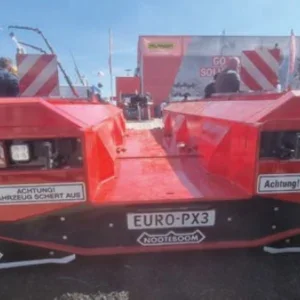The installation of specialised windows during a Swedish hotel construction project was assisted by the use of a new type of access platform which can pivot on its own axis and has recently been developed in Sweden.
Hotel chain Scandic is building a hotel in Mölndal, 20km south of Gothenburg in Sweden. Main contractor is SBS Entreprenad AB.
The six-storey building features cantilevered window assemblies, comprising two panels fixed at right angles to each other, which had to be positioned precisely and held in place in the window apertures while being fastened into place manually.
The window assemblies weighed 270kg yet had to be millimetre perfect in their positioning. Putting enough manpower on the job to hold the window safely would make it difficult to fasten it in place – it would simply be too crowded.
The solution? Hiring an innovative access platform from a new Swedish company, MaxMove, which, in consultation with SBS, adapted one of its MicroMax units for this window installation job.
Despite their versatility, manoeuvrability remains an issue for mobile access platforms. A restricted turning circle makes working in tight spaces difficult and access through a doorway can often be tricky.
To help compensate, manufacturers make lift platforms wide, so a loss of sideways manoeuvrability is disguised by a larger area accessible from the platform. This, of course, only helps in certain applications: a wider machine makes access into and within tight spaces even more difficult.
The solution to most of these difficulties would be to devise a means for allowing movement forward, backwards, or sideways – at any angle – and the ability to pivot the machine on its own axis. With conventional axles this cannot be done, without forcing tyres to twist without changing position. This requires considerable power to overcome friction between wheel and floor, which causes wear and can damage the floor.
MaxMove’s solution is based on the use of a conical wheel driven by a vertical axle; this configuration means that each of these wheels, mounted as a diagonally opposed pair on opposite corners of the chassis, can be rolled around its own axis to point in any chosen direction. When drive is applied, the platform can then move in any direction, with the other diagonally opposed pair of wheels, fitted as trailing castors, following the lead of the powered MaxWheels.
In theory, this means the vehicle can be moved in any direction, and even pivoted on its own axis so long as an appropriate control system is fitted.
The second innovation, a computerised control system, turns theory into practice. The operator has a joystick console, with a small lever to select direction of travel which is indicated by an arrow on a clock display. Moving the joystick moves the lift in the direction of the arrow, and the further the stick is moved, the faster the speed of travel.
MaxMove’s vehicles – the MicroMax, MaxLift, MacroMax and MegaMax – are smaller but, the company claims, more versatile than the conventional solution. They can also be easily and effectively customised to meet users’ specific applications.
SBS site foreman Urban Benon explains: “We hired an adapted MicroMax with specially fitted tools to grip the edges of the window. These special holders were designed and produced by MaxMove specifically for this application at this site after we spoke together. What it means is that instead of having three or four men to lift the window, with the MaxMove equipment the job can be done much quicker with just two men. There are about 100 rooms which are being fitted with these windows, so the time saving is considerable.
“The MaxMove equipment grips the window assembly, then lifts it forward and inches it into the correct position in the window opening. The two workmen manoeuvring it can then position the window so that it can be fastened precisely in place. Obviously, the MaxMove equipment could position the windows much more easily and accurately than it would have been possible to do by hand.” ENTER 520 ON ENQUIRY CARD






